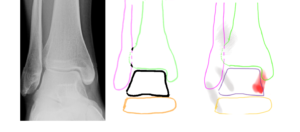The English word Anatomy is derived from the Greek anatome, meaning dissection; and, for many generations of students, the primary center of anatomy instruction was the dissection laboratory. Dissection will no doubt continue to be part of medical school training, if for no reason beyond tradition: the transformation from college senior to freshman medical student begins with the pickling of hands in cadaver preservative. Nevertheless, anatomy instruction must go beyond that: a semester or two of dissection usually provides too much distracting detail for those students not entering the field of surgery and insufficient necessary detail for those who do.
Students certainly can augment their dissections using modern pedagogical tools such as the visible human project (http://www.nlm.nih.gov/research/visible/visible_human.html) or by studying MRI’s, CT scans and the like. But perhaps the best method is a simple one: learning to draw uncomplicated anatomic sketches from memory.
Over 500 years ago, Leonardo da Vinci correctly noted that all muscles work by pulling, not pushing. Therefore, to know a muscle’s origin and insertion is to know its function. Drawing anatomic sketches will help you grasp these relationships and, consequently, understand the workings of the musculoskeletal system.
Begin by tracing x-rays, to produce simple line drawings. After tracing a few times, try to recreate the drawings from memory and add in some details.
Here is a simple tracing of an AP view of the ankle, with the ligaments included:

You may think that sketching seemingly naïve cartoons requires glossing over important details. That may be. Yet this method ensures active focus on the big picture –how the whole comprises its parts–and will provide a solid foundation upon which additional detail can later be layered. Moreover, after drawing from memory you can compare your sketches to the original and determine the extent to which you have mastered the material.
Beyond these sketches, strive to master surface anatomy. A thorough knowledge of surface anatomy will enable you to correlate your understanding of structure and function to a given patient’s presentation. As such, familiarity with surface anatomy will bring your sketches to life. You can certainly learn surface anatomy from cadaveric dissection, but you should also try to learn it from every patient encounter and even from examination of your own surface anatomy.
Throughout medical school, professors will try to convince you that their area of specialty is the most important. For musculoskeletal problems, this issue was resolved long ago: anatomy is the essential discipline. It is also the field of medicine in which the answers are least likely to change from generation to generation. Many of your basic science classes are no doubt vastly different than the ones I took 20 years ago. The anatomy you study, however, is essentially the same corpus of knowledge that was available to da Vinci and all who took an interest in anatomy before him. So learn anatomy well, and reinforce and demonstrate your learn by drawing. If you do so, mastery of musculoskeletal medicine is within your reach.